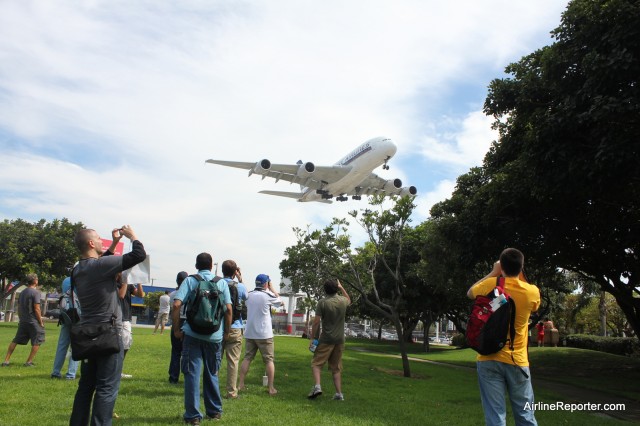
Singapore
Hello AvGeeks!
We thank those of you who keep reading, interacting, and supporting all of us at AirlineReporter. As most of you, know we are more than just a website, but use different forms of social media as ways for you to connect, learn, and enjoy more.
Since we have added some new things in the past few weeks, we wanted to remind you of our other sources and ask that you add/follow us! Here they are:
Thanks for your support!
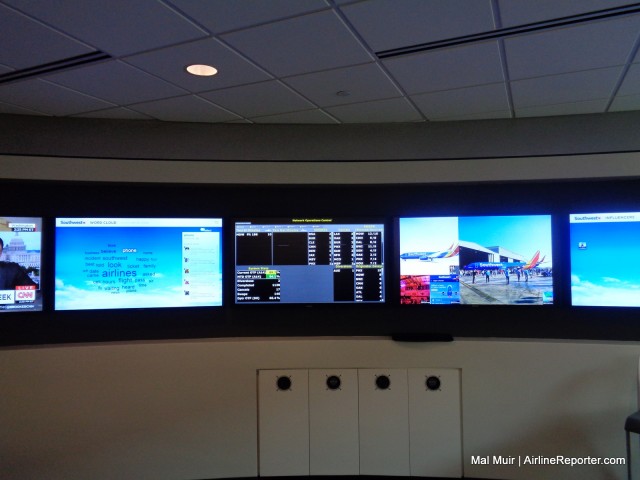
Wall-mounted screens in the new Southwest Airlines Listening Center
Airlines in the modern world seem to use social media one of two ways. Either as an effective marketing tool with no ability to handle any customer service functions, or as a customer service tool with little-to-no ability to market effectively. There are a rare few airlines that can do both of these things and one of them is Southwest. Recently, they began operations in their new Listening Center, a kind of “social media command center” and I had a chance to see how it works.
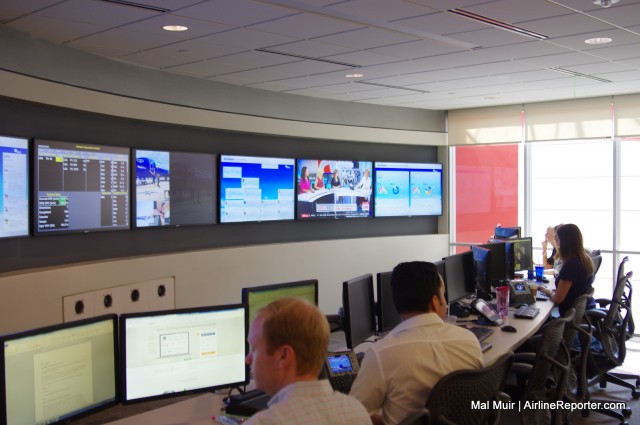
A better look at the set up in the Listening Center
Social media platforms like Facebook, Twitter, and Instagram have become so ingrained into many of our lives. We have access to them on our phones, tablets, and computers – even on watches – that it becomes so overwhelming.
In some forms it is a great way of sharing things with others, like what you are doing or where you are going. However, it is also a great tool in getting a message across or being able to get some things fixed. As social media has grown over the years, it has become more and more apparent that businesses need to address these platforms as a separate communication tool and start to use them effectively. The Listening Center at Southwest is the first of its kind and is staffed by up to nine people at a time.
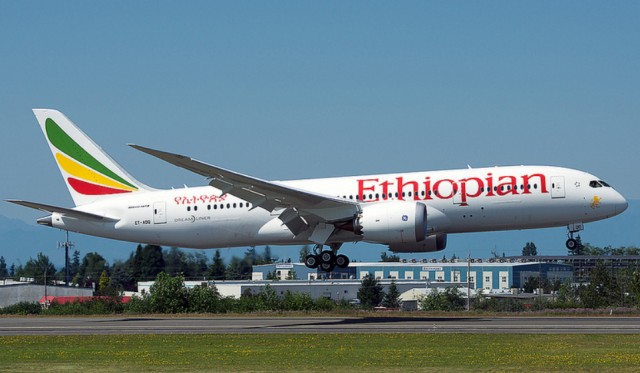
How many Ethiopian 787 photos did you see on the story about a 767? Photo: Bernie Leighton | AirlineReporter
The way people across the globe are able to get their breaking news is changing. I found it very interesting how the Ethiopian flight 702 story was broken and covered.
Personally, I had just wrapped up a great Aviation Geek Fest 2014 and was tired. I decided to head to a bar with Jason Rabinowitz and Ben Granucci (other AvGeeks and some who write for sites like Airchive.com and NYCAviation.com) to have a beer and write some emails. Then I got word from one of our writers, Bernie Leighton, that he thought an airliner had just been hijacked. Jason confirmed he was hearing some rumors as well. It was game time – I switched gears and tried to start confirming what we were seeing.
As Jason and Ben went running to their cars to grab their electronic devices, I started to coordinate with Bernie and our Associate Editor, Blaine Nickeson, via Google chat about who was going to do what with this story.
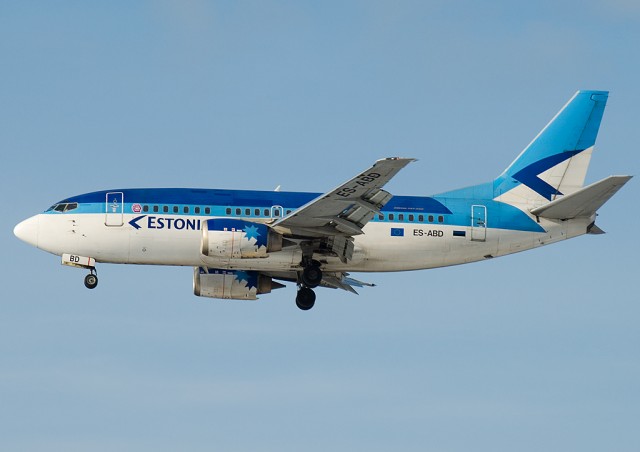
Estonian Air Boeing 737-500.
Estonian Air recently announced that they will start to reward customers for not only flying, but also promoting their brand via social media. The small, regional airline, is the first in the world to reward their passengers for completing tasks, like sharing reviews on Facebook or Tweeting on deals and promotions.
My good friends over at SimpliFlying are working with the airline to show the world that this is the future of customer engagement. ’œToday 88% of frequent flyers use Facebook and they are twice as active as ordinary Facebook users,” Shashank Nigam, CEO of SimpliFlying stated. “Over 70% of them would like to be part of a social loyalty programme too. Estonian Air’s pioneering effort in this field will intensify a pool of advocates for engaging with the airline online. The lessons learned from this can potentially change the course of airline loyalty programmes globally.’
Points are earned through Estonian’s Facebook App called AirScore. You can easily see how many points you have earned and the rewards you can redeem. Social media allows airlines to connect with their customers in ways that no other method can. It makes sense for an airline to reward customers to helping to promote their brand.
“Estonia is a small market and in order to provide good connections at reasonable price for Estonians, the airline needs to also attract connecting traffic from outside Estonia. Social Media is one of the most effective ways to market and promote brands across the borders,’ said Tero Taskila, the CEO of Estonian Air.
I think this is a great experiment and it will be interesting how it turns out. Do you think other airlines might participate in a reward system like this?
Image: Osdu
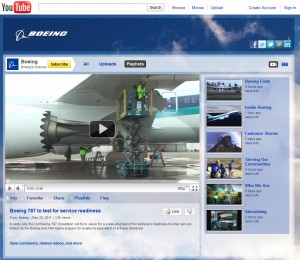
Screen shot of Boeing's new YouTube channel
Social media has become a must-have for most large companies today. Some will approach it with a thought out approach and others do not really know why they are on social media, but just feel they are supposed to be on it. I have enjoyed following Boeing’s slow approach to social media and applaud them for recently adding a YouTube channel.
When I first started this blog about three years ago, the idea of Boeing being on social media was a very foreign concept. Slowly, but surely they have moved from being a company with a closed-door culture to being one that is much more open and shares what is going on with customers and fans of their product.
Boeing first started with operating three Twitter (what is Twitter?) accounts: @Boeing, @BoeingAirplanes and @BoeingDefense. The Twitter accounts cover much more than just repeating news that is already out in the public domain. They have had contests, shared unique photos and personally connected with some of Boeing’s biggest fans.
So why is Boeing on Twitter and YouTube, but not Facebook? Well, the Boeing Store has a Facebook account, but to date Boeing proper still does not. Is this a bad move? Possibly not. Boeing has been taking the “easy-does-it” approach to social media, making sure they master each one before moving onto the next.
When talking to Boeing, it is clear they are looking at how to expand their presence on social media globally, versus just American-based platforms. “We are a global company, ” Todd Blecher, Director of Boeing Communications explained to Airline Reporter. “We need to find ways of becoming a global social media participant.” For example Twitter is not all that popular in China, so Boeing has decided to create a Weibo account to connect with local people and companies.
Adding a YouTube channel is smart, since Boeing is already producing the content. For a long time, Boeing has produced videos to share with employees and it has only been more recently that they have shared these videos via their website. Posting them on YouTube allows more people to view the videos and more importantly, it allows people to comment and interact with Boeing.
YouTube is not the only new thing for Boeing’s videos. On the recent American Airline’s Sky Interior delivery flight, there were only about 20 people on board and Boeing asked a few of the customer-fans who were invited by American Airlines to walk up and down the aircraft at 30,000 feet and give their impression of what they think. No script, no direction, just take a look at the aircraft and give your raw opinion (note: the video has not yet been posted). This is the first time that I have seen Boeing do something like this and it really is a new level of connecting with fans.
Will Boeing continue to grow in other social media formats? I would assume so, but I have been impressed how they continue to better the social media channels they have now to best interact with people outside their company and I look forward to watch them grow.





